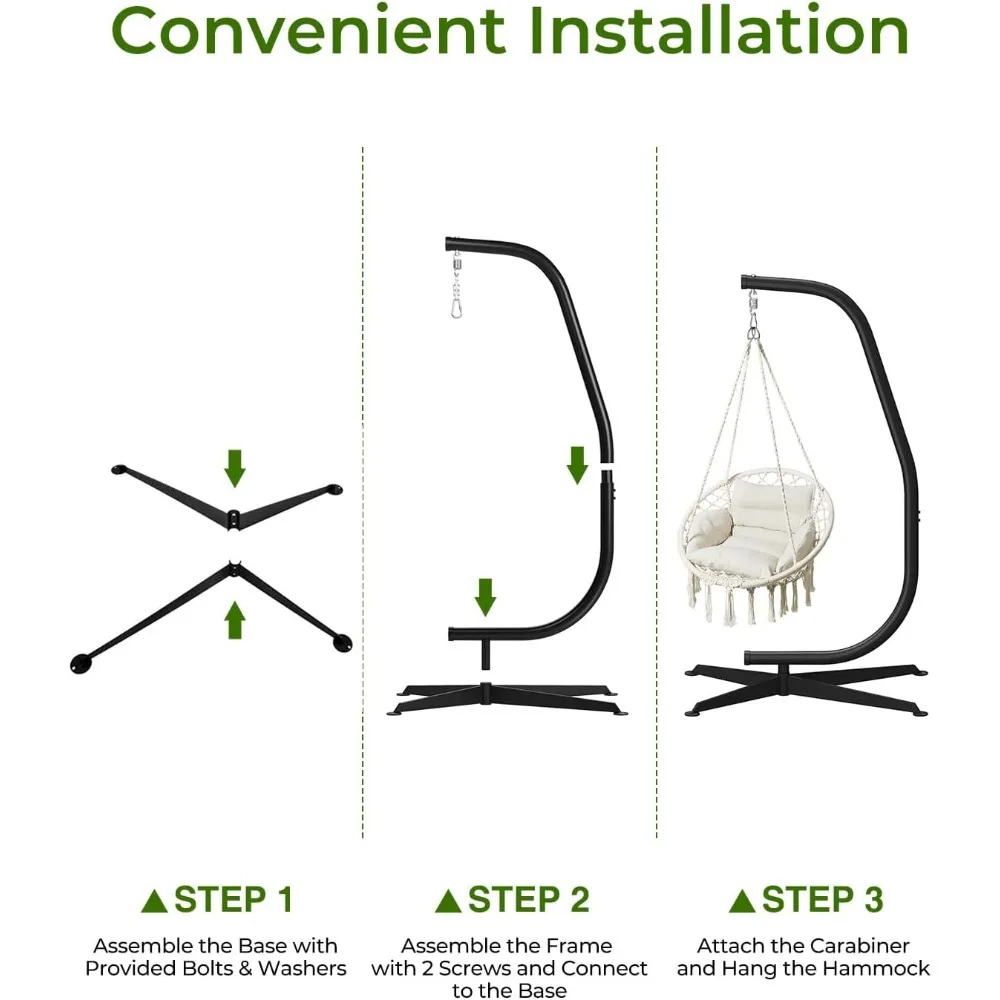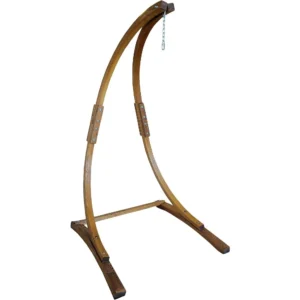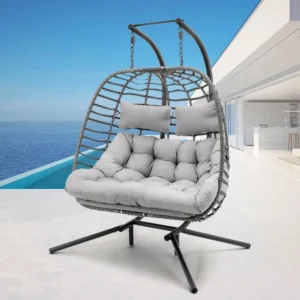The Unique Appeal of Deep Seat Hammocks: Understanding Your Relaxation Cocoon
Deep seat hammocks represent a distinctive evolution in relaxation furniture, setting themselves apart from traditional hammocks through their intentionally deeper sitting position. Unlike regular flat hammocks, these specialty designs create a cocoon-like environment that gently wraps around your body. The unique fabric arrangement forms a protective envelope that delivers an unmatched sense of security and comfort.
What makes deep seat hammocks for lounging so special is their natural ergonomic advantage. The deeper profile allows for:
- Complete body-conforming support that eliminates pressure points
- A gentle embrace sensation that many users find deeply calming
- Natural stress reduction through the feeling of being cradled
- Better temperature regulation within your personal relaxation zone
Many first-time users experience some initial uncertainty about how to properly use these hammocks. That’s completely normal! The ultimate guide to deep seat hammocks highlights how the unique design requires specific techniques to maximize comfort and relaxation potential.
Throughout this guide, we’ll explore exactly how to transform your deep seat hammock experience from merely sitting to truly relaxing. Our premium deep seat chair hammock sets are engineered for ultimate comfort, but understanding proper usage techniques will elevate your experience to new heights of relaxation.
Preparing Your Deep Seat Hammock for Maximum Comfort
Before you can fully enjoy your hammock retreat, proper setup lays the essential groundwork for your relaxation experience. The single most important factor in hammock comfort is achieving the correct suspension angle and sag.
Establish the ideal suspension angle – Aim for approximately a 30-degree angle from your anchor points to the hammock ends. This creates the perfect balance between stability and comfort.
Create proper hammock sag – The hammock should have a gentle curve when unoccupied, with approximately 6-8 inches (15-20 cm) of droop in the middle. A hammock hung too tightly creates uncomfortable pressure points, while excessive sag can make entry and positioning difficult.
Set appropriate hanging height – For most adults, hanging your hammock so the lowest point sits about 18 inches (45 cm) from the ground provides the ideal balance between easy access and proper suspension.
Test and adjust – Sit carefully in your hammock and assess how deeply you sink. You should feel supported without feeling like you’re being swallowed by the fabric.
The specialized deep seat hammock lounging features are designed to create a specific relaxation experience, but they require proper tensioning to function as intended. Take the time to make small adjustments to your setup, as even minor changes in tension or angle can dramatically improve comfort. Remember that hammock relaxation begins before you ever sit down – it starts with thoughtful preparation.
The Art of Getting In: Mastering Entry Without Tipping
One of the most common challenges for deep seat hammock newcomers is the entry process. Mastering this technique prevents the frustration of tipping over and sets the stage for a truly relaxing experience.
The “Sit and Spin” Entry Method:
Begin by standing with the back of your legs touching the hammock’s edge, centered along its length.
Place your hands on the hammock’s edges or sides for stability, keeping your grip firm but not pulling excessively.
Lower yourself to sit on the edge of the hammock as you would on a chair, keeping your feet firmly on the ground.
Maintaining your seated position, pivot (or “spin”) your legs up and into the hammock while simultaneously leaning back.
As you complete the spin, shift your weight toward the center of the hammock while adjusting your position diagonally.
This controlled entry method prevents the sudden weight shifts that cause tipping. If you’re using a hammock with a stand, taming the wobble and stabilizing your double hammock stand is essential for confident entry.
For those with mobility concerns, consider these modifications:
* Position the hammock at a slightly higher height for easier sitting
* Use a small stepping stool for additional stability
* Practice the entry motion several times while having someone spot you
The entry technique becomes second nature with practice, transforming what might initially feel awkward into a smooth transition to relaxation.
Finding Your Sweet Spot: The Diagonal Lay Technique
The diagonal lay is perhaps the most important technique for comfortable hammock relaxation, yet it remains surprisingly underutilized. This positioning method transforms how your body interacts with the hammock’s curve.
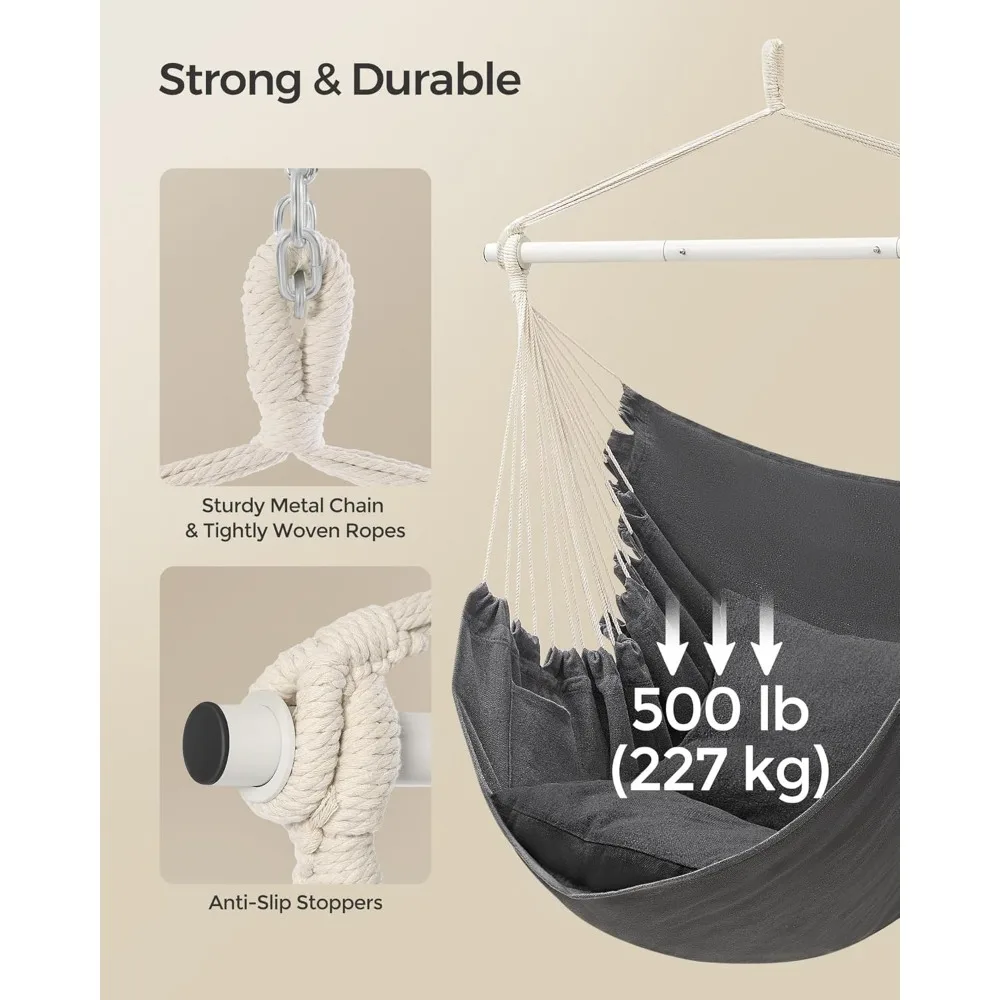
The diagonal position involves laying at an angle across the hammock rather than parallel to its edges. This simple adjustment creates remarkable benefits:
- Flatter lying surface – The diagonal position naturally counters the hammock’s curvature, creating a flatter area for your torso and spine
- Better weight distribution – Your weight spreads more evenly across the hammock surface, eliminating pressure points
- Reduced edge compression – Prevents the sensation of the hammock edges squeezing your shoulders
To find your ideal diagonal position:
After entering the hammock, shift your body approximately 30 degrees off-center from the hammock’s centerline.
Your head should be positioned toward one side of the hammock while your feet angle toward the opposite side.
Adjust your diagonal angle based on your height and the hammock’s dimensions – taller individuals typically need a more pronounced diagonal.
Experiment with slight adjustments until you find your personal “sweet spot” where your body feels most supported.
Understanding the perfect hammock depth for lounging comfort helps you appreciate why this diagonal technique works so effectively. The biomechanics of diagonal positioning naturally counteract the hammock’s curve, allowing your spine to maintain a healthy alignment while feeling fully supported.
Body Alignment Secrets: Optimizing Your Position
Once you’ve mastered the diagonal lay, fine-tuning your body alignment unlocks the deepest levels of hammock comfort. These subtle adjustments make the difference between merely sitting in your hammock and experiencing truly restorative relaxation.
For optimal spinal alignment:
* Position your head and upper back slightly higher than your feet
* Allow your spine to form a gentle curve that follows the hammock’s natural shape
* Avoid twisting your torso, which can create muscle tension
Strategic knee positioning significantly impacts lower back comfort:
* Slightly bend your knees to reduce pressure on your lower back
* If you experience lower back tension, try placing a small pillow or rolled towel under your knees
* Periodically change the degree of knee bend during longer sessions
For shoulder and neck comfort:
* Allow your shoulders to spread naturally across the hammock surface
* If using a pillow, choose one that’s relatively thin to maintain proper neck alignment
* Position the pillow to fill the gap between your neck and the hammock surface
When comparing deep hammocks versus standard hammocks, you’ll notice that deep seat versions require more intentional positioning. While traditional flat hammocks can be more forgiving, deep seat designs offer superior cradling support when properly used.
Remember that your ideal position may differ based on your relaxation goals – reading may require a slightly more upright position than napping, for instance. The key is making small, thoughtful adjustments until you discover your personal comfort zone.
Overcoming Common Discomforts: Troubleshooting Your Experience
Even with proper technique, you might encounter specific discomforts that prevent full relaxation. Identifying and resolving these common issues will transform your hammock experience.
Problem: Shoulder squeeze or feeling confined
Solution: Increase your diagonal angle to approximately 45 degrees, which opens up more shoulder space. Ensure your hammock has adequate sag – a too-tight hammock naturally creates compression. Some users also find relief by slightly raising one side of the hammock higher than the other.
Problem: Calf ridge pressure point
Solution: This uncomfortable pressure at the back of your legs occurs when the hammock’s center seam or gathered fabric creates a ridge. Place a small blanket or towel under your calves to distribute pressure. Alternatively, position yourself more diagonally to shift how this area contacts your legs.
Problem: Cold Butt Syndrome (CBS)
Solution: This unexpected chill occurs when air circulates beneath you, cooling your body through the hammock fabric. Use an insulating pad or specialized hammock underquilt to create a thermal barrier. Even in warm weather, a lightweight throw blanket can eliminate this discomfort.
Problem: Fabric bunching or uncomfortable texture
Solution: Smooth and redistribute the fabric before settling in. For permanent wrinkles or bunching, consider using a hammock pillow to create a buffer zone or explore hammock chairs with stands as an alternative that might better suit your comfort needs.
Problem: Difficulty finding stable position
Solution: Try the “asymmetrical lay” technique where one shoulder is positioned deeper into the hammock than the other. This creates a naturally stable pocket that reduces sliding or shifting during your relaxation session.
These adjustments might seem minor, but they often make the difference between an uncomfortable experience and blissful relaxation in your deep seat hammock.
Essential Accessories for Elevated Comfort
While proper positioning forms the foundation of hammock comfort, thoughtfully chosen accessories can elevate your experience to new heights of relaxation.
Strategic pillow placement transforms your comfort level:
* A small, compressible pillow behind your neck provides crucial support while maintaining proper alignment
* A thin cushion under your knees helps reduce lower back pressure
* Body-length pillows can be positioned along your side to create a supportive boundary
Blankets and quilts serve multiple comfort functions:
* Preventing Cold Butt Syndrome through insulation
* Creating a softer surface texture against your skin
* Allowing temperature adjustments during longer relaxation sessions
* Adding a psychological comfort element that enhances relaxation
For extended lounging or overnight use, consider:
* A lightweight sleeping pad cut to hammock width for both insulation and pressure distribution
* A specialized hammock underquilt that hangs beneath the hammock to eliminate compression of insulating materials
* An integrated bug net for outdoor relaxation without interruptions
Convenience enhancers worth considering:
* Attachable cup holders or side pockets to keep essentials within reach
* Small clip-on reading light for evening relaxation
* Weather-appropriate accessories like rain flies for outdoor setups
Understanding the essential features of cozy quilted hammocks helps you select accessories that complement your specific hammock design. The beauty of these additions is that they can be customized to your personal preferences and needs, transforming a good relaxation experience into something truly exceptional.
Creating Your Perfect Relaxation Environment
The physical setting surrounding your hammock plays a crucial role in achieving deep relaxation. Creating an intentional environment enhances the mental and emotional aspects of your hammock experience.
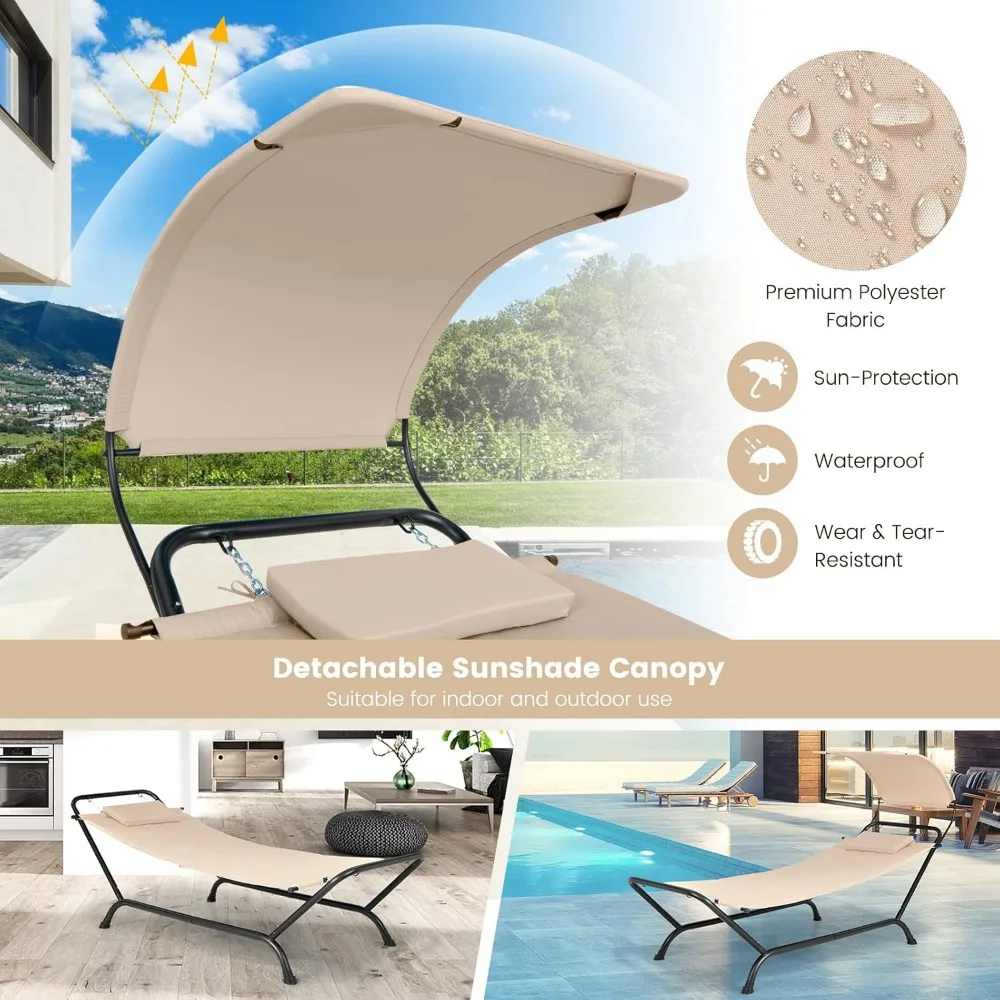
When selecting your hammock location, consider these environmental factors:
* Balanced sun/shade exposure that suits your temperature preferences
* Visual elements that promote relaxation (nature views, pleasing colors, minimal clutter)
* Privacy level appropriate for your comfort and relaxation needs
* Protection from disruptive elements (strong winds, excessive noise)
The auditory environment significantly impacts relaxation quality:
* Natural sounds like flowing water or gentle breezes enhance relaxation
* Considerate use of relaxing music or nature recordings can mask disruptive noises
* Creating a sound boundary with white noise machines for indoor setups
* Embracing periods of intentional quiet for deeper meditative relaxation
Temperature management ensures sustained comfort:
* Position indoor hammocks away from direct HVAC airflow
* Use ceiling fans for gentle air circulation without direct drafts
* Consider seasonal adjustments to location or accessories
* Explore hammock sets with canopy for outdoor shade control
Personalize your relaxation zone with elements that speak to your senses:
* Subtle aromatherapy with natural scents known to promote relaxation
* Tactile comfort elements like soft throws or cushions
* Easy access to relaxation enhancers like books, journals, or refreshments
These environmental considerations work together with proper hammock technique to create a multi-sensory experience that facilitates deeper relaxation and enjoyment.
Dark Wood Hammock Sets, Porch Swing Chair Sets
$653.82 Select options This product has multiple variants. The options may be chosen on the product pageA-Frame Stand Hammock Sets, Swinging Hammock Chair Sets
$154.62 Select options This product has multiple variants. The options may be chosen on the product pageLight Wood Hammock Sets, Swinging Hammock Chair Sets
$1,359.35 Select options This product has multiple variants. The options may be chosen on the product pageHammock Sets with Canopy, Heavy Duty Hammock Sets
$286.31 Select options This product has multiple variants. The options may be chosen on the product page- $963.29 Select options This product has multiple variants. The options may be chosen on the product page
Complete Camping Hammock Systems, Hanging Egg Chair Sets
$266.73 Select options This product has multiple variants. The options may be chosen on the product page
Mindful Relaxation: Techniques for Deeper Hammock Enjoyment
The gentle, cradling environment of a deep seat hammock creates the perfect setting for mindful relaxation practices. By intentionally combining physical comfort with mental techniques, you can transform simple hammock time into profound relaxation.
Embrace the gentle rocking motion – Allow yourself to notice and appreciate the subtle swaying. This natural movement has been shown to synchronize brain waves and promote deeper relaxation states. Rather than fighting small movements, incorporate them into your relaxation process.
Practice hammock-specific breathing – The unique positioning of a deep seat hammock naturally opens your chest cavity. Take advantage by practicing diaphragmatic breathing: slowly inhale for a count of four, hold briefly, then exhale for a count of six. Feel your body sink deeper into the hammock with each exhale.
Try progressive muscle relaxation – Starting with your feet and moving upward, tense each muscle group for 5 seconds before releasing. The supportive nature of deep seat hammock designs creating relaxation enhances this technique by providing consistent feedback about where you’re holding tension.
Engage in sensory mindfulness – Cycle through your senses while in the hammock. Notice five things you can see, four things you can touch, three things you can hear, two things you can smell, and one thing you can taste. This grounding technique deepens your connection to the present moment.
The hammock’s gentle embrace naturally facilitates these mindfulness practices by creating a contained, supportive environment. The slight separation from your surroundings helps transition your mind from active thinking to receptive awareness – a perfect state for meaningful relaxation.
Exit Strategy: Leaving Your Hammock with Grace and Ease
Exiting your hammock with confidence prevents ending your relaxation session with an awkward dismount. Follow these steps for a smooth transition back to standing:
Begin by shifting from your diagonal position back to the center of the hammock.
Use your hands to grip both sides of the hammock for stability.
Swing your legs to one side and over the edge of the hammock until your feet touch the ground.
While keeping your hands on the hammock edges for support, use your leg muscles to stand up from your seated position.
Release the hammock slowly to prevent it from swinging excessively.
If you have mobility concerns, consider these modifications:
* Position your hammock at a height where your feet easily reach the ground when seated
* Use your hands to push against the hammock fabric for additional leverage when standing
* Take your time – moving slowly prevents loss of balance
For deep seat hammocks with higher sides, scoot toward the edge before swinging your legs over to reduce the height you need to navigate. Remember that exiting takes practice, and each hammock style might require slight adjustments to the basic technique.
Hammock Maintenance for Sustained Comfort
Maintaining your hammock properly ensures it continues to provide optimal relaxation for years to come. Regular care preserves both comfort features and structural integrity.
Establish a routine inspection habit:
* Check suspension points and hardware for signs of wear or corrosion
* Examine the fabric for stretched areas, small tears, or weakened stitching
* Test any spreader bars or supports for stability
* Verify that stands or frames remain properly aligned and stable
Proper cleaning preserves comfort and extends lifespan:
* Follow manufacturer-specific cleaning instructions for your hammock material
* Address spills or stains promptly to prevent setting
* Allow hammocks to thoroughly air dry before storage to prevent mildew
* Consider using a gentle fabric brush to remove dust and debris from textured fabrics
Storage practices significantly impact comfort longevity:
* Store indoor hammocks away from direct sunlight when not in use
* Keep swinging hammock chair sets in protective covers during off-seasons
* Avoid folding hammocks along the same creases repeatedly
* Store in dry environments to prevent moisture damage
Seasonal adjustments maintain consistent comfort:
* Tighten or loosen suspension as humidity and temperature change
* Replace weathered accessories like pillows or padding as needed
* Reassess your setup after heavy use periods
This proactive maintenance approach ensures your hammock remains as comfortable on day one thousand as it was on day one.
Beyond Relaxation: Creative Ways to Enjoy Your Deep Seat Hammock
Your deep seat hammock can serve multiple purposes beyond basic relaxation. Exploring these creative uses expands the value of your investment and integrates it more fully into your lifestyle.
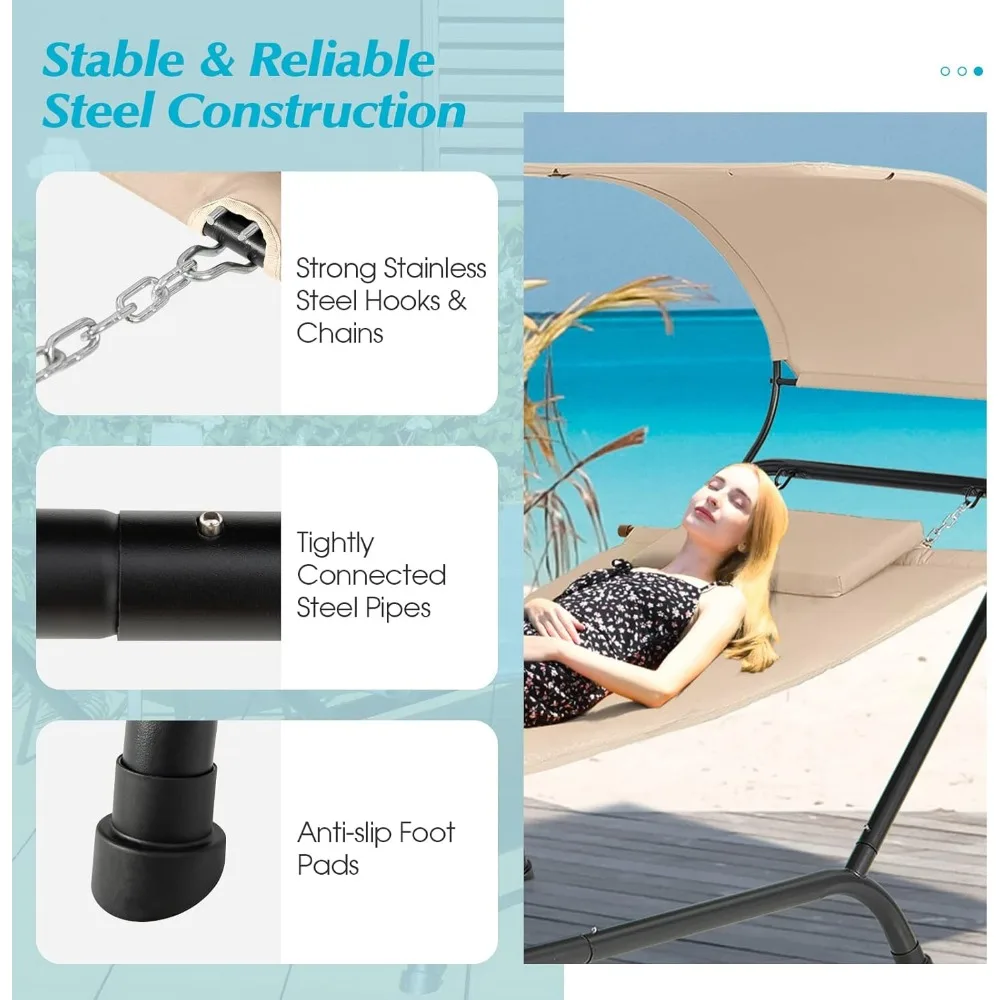
Reading enthusiasts can optimize their hammock experience:
* Position yourself at a slightly more upright diagonal angle
* Use a small pillow under your elbows to prevent arm fatigue
* Consider a book holder accessory for hands-free reading
* Adjust your position periodically to maintain comfort during extended reading sessions
Social hammocking creates unique connection opportunities:
* Position the hammock to facilitate conversation with nearby seating
* For larger hammocks, practice the side-by-side sitting technique with a friend
* Create a hammock conversation area with multiple hammocks in proximity
* Use your hammock as a novel setting for meaningful one-on-one conversations
Mindful meditation benefits from the hammock environment:
* The gentle containment helps limit physical fidgeting
* Natural rocking motion can serve as a focus point for attention
* The physical separation from regular seating creates a dedicated mental space
* Overhead views provide a different perspective for open-eye meditation
Recovery and gentle stretching:
* Use the hammock’s support for supported back stretches
* Practice supported leg raises by gripping the hammock sides
* Enjoy passive stretching as gravity gently works with your body weight
* Experience enhanced post-exercise recovery through elevated positioning
By exploring these alternative uses, your Outside Luxe hammock becomes more than just a relaxation tool – it becomes an integrated part of your wellbeing routine.
Is It Possible to Sleep All Night in a Deep Seat Hammock?
While deep seat hammocks excel at supporting short to medium relaxation sessions, many wonder if they can provide comfortable overnight sleep. The answer depends on several factors including your sleep preferences, the specific hammock design, and proper sleep setup.
Many cultures around the world have long traditions of hammock sleeping, suggesting it’s certainly possible with the right approach. Compared to short relaxation sessions, overnight hammock sleep requires additional considerations:
- Body positioning becomes even more crucial – the diagonal lay technique is essential for spinal alignment during extended periods
- Temperature management needs more attention, as your body cools during sleep
- Additional accessories like specialized pillows or underquilts become more important
- Adapting to the unique sleep surface typically requires an adjustment period
The advantages of overnight hammock sleep include natural pressure point elimination, potential benefits for those with back pain, and the gentle rocking that some find helps induce deeper sleep. While many wonder about sleeping in hammock chairs, deep seat hammocks generally provide better full-body support for extended overnight use.
If you’re interested in trying overnight hammock sleep, start with naps to gradually acclimate your body to the different sleep position and sensation before attempting a full night.
When Your Hammock Isn’t Comfortable (Despite Your Best Efforts)
Sometimes, despite applying all the right techniques, your hammock experience might still feel less than perfect. Understanding potential underlying causes can help you troubleshoot persistent discomfort.
First, consider whether your hammock properly matches your body type and preferences. Factors that impact compatibility include:
- Hammock length relative to your height (generally, the hammock should be at least 2 feet longer than your height)
- Fabric elasticity and how it responds to your body weight
- Width adequacy for your preferred sleeping position
- Deep seat design that matches your comfort preferences
Common hammock myths can also interfere with comfort expectations:
* The misconception that hammocks must be hung tight (they actually need proper sag)
* The belief that back pain is inevitable (proper diagonal positioning prevents this)
* The idea that all hammocks create the same sleeping surface (designs vary significantly)
If you’ve thoroughly tried all positioning techniques without success, it may be time to explore alternative designs. The most comfortable hammock type for each person varies based on individual preferences, sleeping styles, and body characteristics. Some people simply find they prefer hammock chairs or more traditional flat hammocks to deep seat designs.
Remember that hammock comfort is highly individualized – finding your perfect match might require exploring different styles or designs.
Creating Your Personal Hammock Relaxation Ritual
Transforming hammock time from a casual activity into an intentional relaxation practice amplifies its benefits. Developing your personal hammock ritual creates a psychological trigger that helps your mind and body transition into relaxation mode more quickly.
Consider building a simple sequence that signals relaxation time:
* Begin with a brief stretching routine before entering your hammock
* Take three deep breaths after settling into your position
* Mentally set aside specific worries or to-do lists for the duration of your session
* Allow yourself to fully sink into the hammock’s embrace
Consistency enhances the effectiveness of your hammock ritual. Even short but regular relaxation sessions deliver greater benefit than occasional longer sessions. Best deep hammocks for ultimate relaxation provide the perfect environment for establishing this consistent practice.
Your hammock can become a central element in your overall wellness approach. Some users find that hammock time becomes a natural space for gratitude practice, visualization, or simply enjoying a few moments of unstructured thought. The specific elements of your ritual matter less than the intentionality behind them.
By approaching hammock relaxation as an art to be mastered rather than a passive activity, you transform a simple piece of furniture into a powerful tool for wellbeing. Your deep seat hammock becomes not just something you own, but something that actively contributes to your quality of life.

